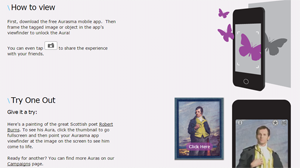 A new frontier in educational technology is captivating teachers and students. Today’s classroom is multidimensional and multimodal. Educators want to capitalize on motivating experiences for learning but have limited time to plan and create the resources. Yet, with the support of students, a constructivist approach to blended learning is becoming a reality.
A new frontier in educational technology is captivating teachers and students. Today’s classroom is multidimensional and multimodal. Educators want to capitalize on motivating experiences for learning but have limited time to plan and create the resources. Yet, with the support of students, a constructivist approach to blended learning is becoming a reality.
Augmented reality is an emerging resource that composites multimedia in front of real-world objects. The result is an outstanding virtual interaction within the user’s current environment. The interaction is controlled by the movement of a handheld device that is equipped with a camera, including most smartphones and tablets. Imagine visiting a museum where the paintings and sculptures come alive in an interactive exhibit for gathering research within your classroom. In the dynamic world of augmented reality, almost everyone can be a participant with only the aid of a personal device.
Unlike the promises of virtual reality, expensive headsets and controllers are no longer necessary. Using a tablet or smartphone, any space with wireless Internet access can become a virtual environment. In their TED talk, Matt Mills and Tamara Roukaerts demonstrated how augmented reality is neither cost-prohibitive nor time-consuming to produce. Through the benefit of free cross-platform apps including Aurasma and Layar, anyone can create a quick, interactive experience within a few minutes.
Last year, my co-teacher and I created a virtual town of Hannibal, MO, for our class reading of Mark Twain’s The Adventures of Huckleberry Finn. Using a series of designated “markers,” the classroom was transformed into virtual learning stations. One station featured a video of the mechanics of a steamship superimposed over an empty box. Another corner of the room created a virtual window where historians narrated a scene in the typical 19th-century town. A tabletop with a copy of the book became the virtual desk of the author, providing a brief bibliography of his other writings. Best of all, students created posters that summarized segments of the story and created a gallery walk. When viewed through augmented reality, the student appeared in the poster and analyzed the meaning in a brief oral presentation.
Open house visits from parents can be extra engaging with augmented reality. Navigating the school’s halls can include animated directions similar to GPS navigators. Students, like those at the Shaw Wood Primary School, can produce exhibits easily sharable with parents, both at home and in school. Administrations can share interactive data walls with the community and publicize special events as movie trailers.
Charles Cooper has demonstrated how augmented reality transformed his classroom. Using the Aurasma app, he created a video on how to solve mathematical problems and connect to formative assessments. Librarians can create simple book trailers to help students select books by interest. Additionally, those students can produce a video book review that can be linked to the book for future readers.
The most promising aspect of augmented reality is that it does not replace traditional modes of text. Schools that are concerned about the relevance of textbooks and other print material have nothing to fear. Augmented reality has been incorporated in numerous popular publications and provides exciting opportunities for interaction. The content is also not limited to pictures and video, but also three-dimensional models capable of live interaction. Thus, a textbook can receive updated content reflecting current pedagogy or events.
Furthermore, many augmented reality programs allow for geo-coding, the ability to root the interaction to a specific location. My students find this feature to be highly engaging when creating team scavenger hunts at school. These techniques have also been used in the gaming community as a means of virtual gaming and at home, interactive shopping.
As educators, we are looking for ways to engage our students and meet our curricular expectations. Augmented reality allows students to practice close reading by embedding supportive text on the page before them. It allows students to be media makers of traditional and digital texts in symbiotic fashion. Most of all, it is accessible to more individuals through the growing smart device market and is more cost effective than full scale one-to-one initiatives. Empowering our students with augmented reality will have a critical impact on the future of literacy and blended learning.
 Mark Davis is a reading specialist at Barrington High School, in Barrington, RI. Mark has presented at national conferences including those sponsored by the ASCD, ILA, Learning Forward, Learning First Alliance, American Reading Forum, and numerous regional workshops. He is currently in his second year in the Feinstein Fellows doctoral program with the University of Rhode Island and Rhode Island College.
Mark Davis is a reading specialist at Barrington High School, in Barrington, RI. Mark has presented at national conferences including those sponsored by the ASCD, ILA, Learning Forward, Learning First Alliance, American Reading Forum, and numerous regional workshops. He is currently in his second year in the Feinstein Fellows doctoral program with the University of Rhode Island and Rhode Island College.
This article is part of a series from the International Reading Association’s Technology in Literacy Education Special Interest Group (TILE-SIG).